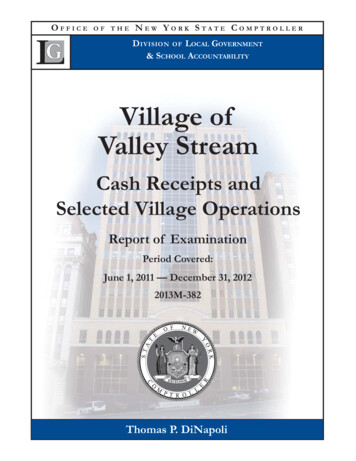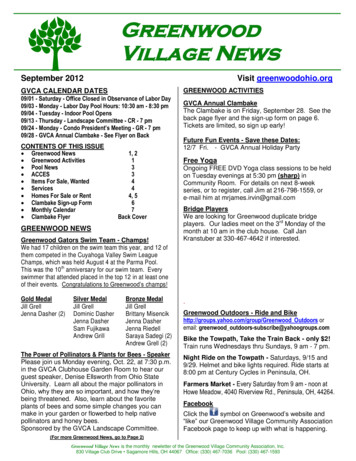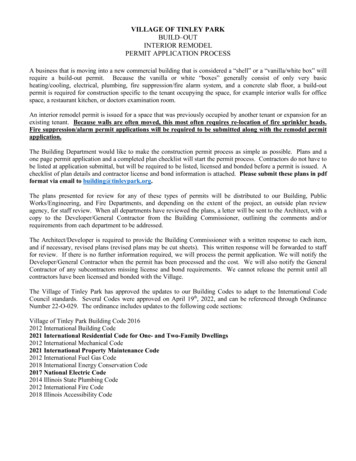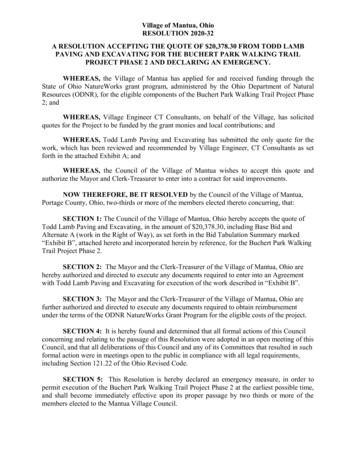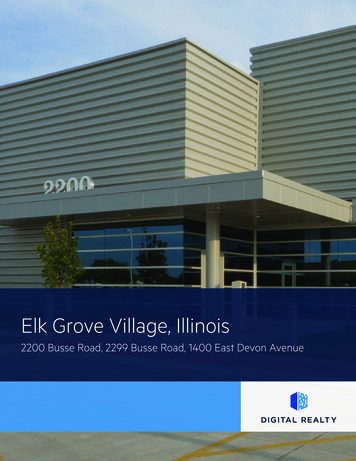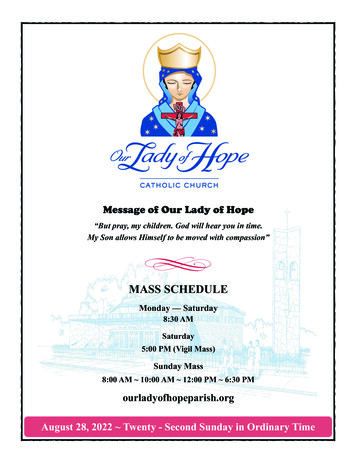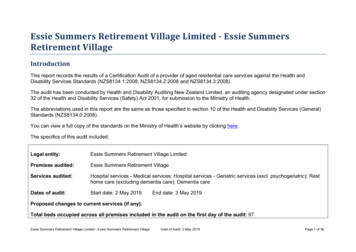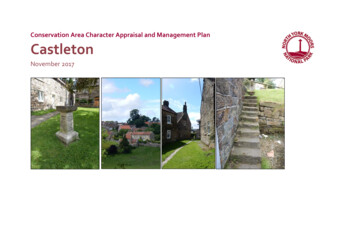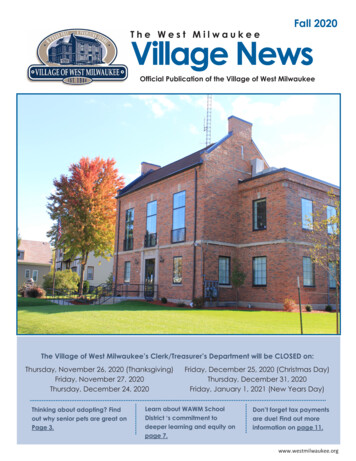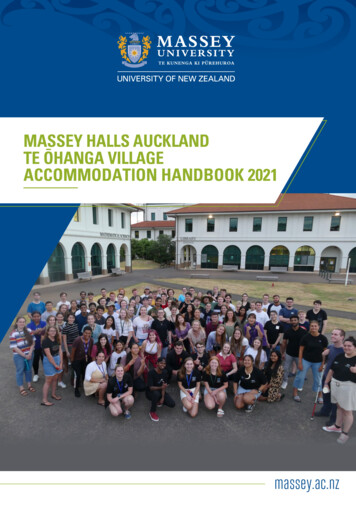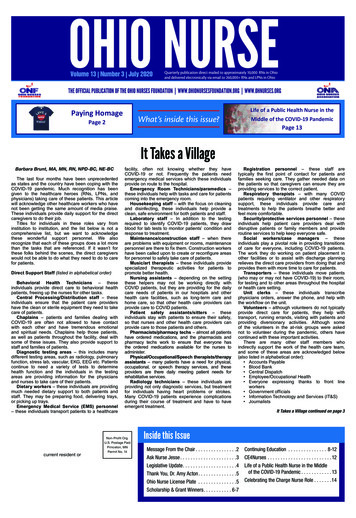
Transcription
Volume 13 Number 3 July 2020Quarterly publication direct mailed to approximately 10,000 RNs in Ohioand delivered electronically via email to 260,000 RNs and LPNs in OhioLife of a Public Health Nurse in thePaying HomageWhat’s inside this issue?Page 2Middle of the COVID-19 PandemicPage 13It Takes a VillageBarbara Brunt, MA, MN, RN, NPD-BC, NE-BCThe last four months have been unprecedentedas states and the country have been coping with theCOVID-19 pandemic. Much recognition has beengiven to the healthcare heroes (RNs, LPNs, andphysicians) taking care of these patients. This articlewill acknowledge other healthcare workers who havenot been getting the same amount of media praise.These individuals provide daily support for the directcaregivers to do their job.Titles for individuals in these roles vary frominstitution to institution, and the list below is not acomprehensive list, but we want to acknowledgethese wonderful support personnel. We alsorecognize that each of these groups does a lot morethan the tasks that are referenced. If it wasn’t forthese folks behind the scenes, the direct caregiverswould not be able to do what they need to do to carefor patients.Direct Support Staff (listed in alphabetical order)Behavioral Health Technicians – theseindividuals provide direct care to behavioral healthpatients, freeing up the nurses for other tasks.Central Processing/Distribution staff – theseindividuals ensure that the patient care providershave the clean or sterile equipment they need to takecare of patients.Chaplains – patients and families dealing withCOVID-19 are often not allowed to have contactwith each other and have tremendous emotionaland spiritual needs. Chaplains help those patients,as well as patients throughout the facility, deal withsome of these issues. They also provide support tostaff and families of patients.Diagnostic testing areas – this includes manydifferent testing areas, such as radiology, pulmonaryfunction, stress lab, vascular, EKG, EEG etc. Patientscontinue to need a variety of tests to determinehealth function and the individuals in the testingareas are providing information for the physiciansand nurses to take care of their patients.Dietary workers – these individuals are providingmuch needed dietary support to both patients andstaff. They may be preparing food, delivering trays,or picking up trays.Emergency Medical Service (EMS) personnel– these individuals transport patients to a healthcarecurrent resident orfacility, often not knowing whether they haveCOVID-19 or not. Frequently the patients needemergency medical services which these individualsprovide on route to the hospital.Emergency Room Technicians/paramedics –these individuals help with tasks and care for patientscoming into the emergency room.Housekeeping staff – with the focus on cleaningand disinfecting, these individuals help provide aclean, safe environment for both patients and staff.Laboratory staff – In addition to the testingrequired to identify COVID-19 patients, they drawblood for lab tests to monitor patients’ condition andresponse to treatment.Maintenance/construction staff – when thereare problems with equipment or rooms, maintenancepersonnel are there to fix them. Construction workershave been called upon to create or reconfigure areasfor personnel to safely take care of patients.Music/art therapists – these individuals providespecialized therapeutic activities for patients topromote better health.Nursing assistants – depending on the settingthese helpers may not be working directly withCOVID patients, but they are providing for the dailycare needs of patients in our hospitals and otherhealth care facilities, such as long-term care andhome care, so that other health care providers canprovide care to COVID patients.Patient safety assistants/sitters – theseindividuals stay with patients to ensure their safety,so that nurses and other health care providers canprovide care to those patients and others.Pharmacists/pharmacy techs – almost all patientshave ordered medications, and the pharmacists andpharmacy techs work to ensure that everyone hasthe ordered medications available for the nurses toadminister.Physical/Occupational/Speech therapists/therapyassistants – many patients have a need for physical,occupational, or speech therapy services, and theseproviders are there daily meeting patient needs forrehabilitative services.Radiology technicians – these individuals areproviding not only diagnostic services, but treatmentfor individuals having heart problems or strokes.Many COVID-19 patients experience complicationsduring their course of treatment and have to haveemergent treatment.Non-Profit Org.U.S. Postage PaidPrinceton, MNPermit No. 14Registration personnel – these staff aretypically the first point of contact for patients andfamilies seeking care. They gather needed data onthe patients so that caregivers can ensure they areproviding services to the correct patient.Respiratory therapists – with many COVIDpatients requiring ventilator and other respiratorysupport, these individuals provide care andtreatments to help the patients breathe better andfeel more comfortable.Security/protective services personnel – theseindividuals help patient care providers deal withdisruptive patients or family members and provideroutine services to help keep everyone safe.Social workers/case managers – theseindividuals play a pivotal role in providing transitionsof care for everyone, including COVID-19 patients.The work they do working on patient placement inother facilities or to assist with discharge planningrelieves the direct care providers from doing that andprovides them with more time to care for patients.Transporters – these individuals move patients(who may or may not have COVID-19) to their room,for testing and to other areas throughout the hospitalor health care setting.Unit clerks – these individuals transcribephysicians orders, answer the phone, and help withthe workflow on the unit.Volunteers – although volunteers do not typicallyprovide direct care for patients, they help withtransport, running errands, visiting with patients andproviding diversionary activities. Although someof the volunteers in the at-risk groups were askednot to volunteer during the pandemic, others havecontinued with these important activities.There are many other staff members whoindirectly support the work of the health care team,and some of these areas are acknowledged below(also listed in alphabetical order): Accounts Payable Blood Bank Central Dispatch Employee/Occupational Health Everyone expressing thanks to front lineworkers Government officials Information Technology and Services (IT&S) JournalistsIt Takes a Village continued on page 3Inside this IssueMessage From the Chair. . . . . . . . . . . . . . . . 2Ask Nurse Jesse. . . . . . . . . . . . . . . . . . . . . . 3Continuing Education . . . . . . . . . . . . . . . . 8-12CE4Nurses . . . . . . . . . . . . . . . . . . . . . . . . . 12Legislative Update. . . . . . . . . . . . . . . . . . . . . 4Thank You, Dr. Amy Acton. . . . . . . . . . . . . . . 5Ohio Nurse License Plate . . . . . . . . . . . . . . . 5Scholarship & Grant Winners. . . . . . . . . . . 6-7Life of a Public Health Nurse in the Middleof the COVID-19 Pandemic. . . . . . . . . . . . 13Celebrating the Charge Nurse Role. . . . . . . 14
Page 2Ohio NurseJuly 2020MESSAGE FROM THE CHAIRPaying HomageThe Ohio Nurses Foundationas lens wipes, as disinfecting(ONF) partnered with Columbuswipes left face shields cloudy andcompanyHomagetohonordifficult to see. Other money hasnurses. I googled the wordbeen used to purchase supplies to“homage” and it means to showmake care packages (over 200 torespect.date) for our members who haveHomage created T-shirts withbeen quarantined at home.“Love a Nurse Today” on the front.The ONF board made an initialHomagecommittedtocontribution of 10,000 to this fundcontributing 20% of the T shirtfrom our treasury. Because of thesales to ONF. As I write this,success of the Homage campaignwe have received 15,000 fromand the continued need to supportHomage. We’ve also received aour colleagues on the front line,contribution of 10,000 from thethe ONF board voted to contributeMid-Ohio District, 2,500 fromanother 10,000 from our treasury.the Steelworkers and severalI haven’t worked in directgenerouscontributionsfrompatient care for years. It’s beenSusan Stocker, RNindividuals. A woman in Floridaheartbreaking to see and hearONF Chairsaw the interview Rick Lucas didthe stories of our colleagues whoabout an OSUNO member who lost her home inare working on the frontlines during this crisis.a fire and sent a check for 1,000. All in all, we’veYes, its nurses working in acute care. It’s alsocontributed over 50,000 to help our colleaguesnurses working in long term care, home care andworking on the frontlines who are in need. Thatprisons, who may be the most vulnerable.money has been used to purchase supplies suchIn closing, I want to say thank you once againto all the nurses working on the frontline duringthe COVID 19 crisis. I want to thank everyonewho has contributed to the ONF Pandemic fundso we can reach out and help our colleagues inneed. And finally, I want to thank Homage for theirleadership and philanthropy. Together, we aremaking a difference.Hiring RNs, LPNs& STNAs.Contact Heather Borrelli at hborrelli@elizajen.orgor 216-904-6745 to apply.10603 Detroit Ave.,Cleveland, OH 44102WE ARE LOOKING FOR:RNs, LPNs, and STNAs (all shifts)l Get Paid Weekly! l Graduate Nursesare welcome to apply! l STNA WeekendWarrior l Offer classes to become STNAsPlease visit careers.saberhealth.com/to apply or call (937) 399-8311for more information.Springfield Nursing and Independent Living404 E. McCreight Ave. Springfield, OH 45503Homage t-shirts available O NURSEThe official publication of theOhio Nurses Foundation3760 Ridge Mill DriveHilliard, OH 43026(614) 237-5414Web site: www.ohionursesfoundation.orgArticles appearing in the Ohio Nurse arepresented for informational purposes only andare not intended as legal or medical adviceand should not be used in lieu of such advice.For specific legal advice, readers shouldcontact their legal counsel.2020-2022 Ohio Nurses FoundationBoard of DirectorsCHAIRPERSON: Susan StockerVICE PRESIDENT: Shelly MalbertiTREASURER: Annie BowanSECRETARY: Joyce PowellDIRECTORS:Paula AndersonNancy McManusGina SeverinoBarbara WelchCEO / PRESIDENT:Lisa OchsThe Ohio Nurse is published quarterly inJanuary, April, July, and October.Address Changes: The Ohio Nurse obtains itsmailing list from the Ohio Board of Nursing. Sendaddress changes to the Ohio Board of Nursing:17 South High Street, Suite 400Columbus, OH 43215614-466-3947www.nursing.ohio.govFor advertising rates and information, pleasecontact Arthur L. Davis Publishing Agency, Inc.,517 Washington Street, PO Box 216, Cedar Falls,Iowa 50613, (800) 626-4081, sales@aldpub.com.ONF and the Arthur L. Davis Publishing Agency,Inc. reserve the right to reject any advertisement.Responsibility for errors in advertising is limitedto corrections in the next issue or refund of priceof advertisement.Acceptance of advertising does not implyendorsement or approval by the Ohio NursesFoundation of products advertised, theadvertisers, or the claims made. Rejection ofan advertisement does not imply a productoffered for advertising is without merit, or thatthe manufacturer lacks integrity, or that thisFoundation disapproves of the product or itsuse. ONF and the Arthur L. Davis PublishingAgency, Inc. shall not be held liable for anyconsequences resulting from purchase or useof an advertiser’s product. Articles appearingin this publication express the opinions of theauthors; they do not necessarily reflect viewsof the staff, board, or membership of ONF.
July 2020Ohio NursePage 3ASK NURSE JESSEDear Nurse Jesse, I feel conflicted as a nurse because Dr. Acton hasdone a wonderful job protecting Ohioans, but I also understand others’concerns about the Director of ODH having too much power. Is there trulya lack of checks and balances?This is a great question and this topic is one that has drawn quite a bit ofcontroversy on ONA’s Facebook page over the last several weeks. From thebeginning, ONA has applauded the proactive steps Governor DeWine and Dr.It Takes a Village continued from page 1 Library ServicesMedical EducationNational GuardMedical RecordsParking ServicesResearchUtilization Review and Quality ImprovementValet ServicesThere are many individuals and groups outside the health care team whohelped during this pandemic. Many companies have reconfigured their operationsto help with the supply of needed equipment, individuals have volunteered theirtime to help others, grocery stores have donated food and supplies to medicalworkers, truck drivers have been transporting equipment and supplies to keepshelves full, and entertainers have donated their time and talent to providediversions for everyone who has had to stay at home. Parents are learning howto teach their children, individuals are finding creative ways to celebrate specialoccasions, and everyone has had to learn to adapt to a new “normal.”It does take a village. To everyone who has helped during this health carepandemic, we say:Thank you!Gallup Indian Medical CenterNow, more than ever, we appreciate and value yourcompassionate and loyal care to our community.Thank you!We are hiring Registered Nurses!79 Bed, Baby Friendly, Trauma III designated hospitalbordering the Navajo Nation in Gallup, NM.Med/Surg, OB/L&D, ICU, Ambulatory Care, ER, Peds, Periop& other specialty positions available.We offer:Competitive SalariesRelocationRecruitment/Retention IncentivesLoan RepaymentContact:Myra Francisco, RN – Nurse Recruiter505.726.8549 myra.francisco@ihs.govhttp://bit.ly/gsu-rnI.H.S. is required by law to give absolute preference to qualified Indian applicants. Equal Opportunity Employer.Amy Acton have taken to fight the war against COVID-19 in the state of Ohio.The recent pandemic has placed additional pressure on the current healthcaresystem, causing nurse staffing issues and lack of equipment. ONA is confidentthat Ohio would not have had enough nurses and other healthcare professionalsavailable to care for Ohioans if the administration and the extension of theexecutive branch, including Dr. Acton, had not intervened early. DeWine,Lieutenant Governor Husted, and Director Acton have been true leaders notonly in Ohio, but across the nation. ONA acknowledges the economic impactCOVID-19 has had on businesses across the state, including Ohio hospitals andambulatory surgery centers. However, it is ONA’s position that an economy canonly recover if it has a strong, healthy workforce in place.Since its inception in 1886, the Department of Health has had the authorityto issue orders to curb the spread of infectious disease. Per the Ohio RevisedCode, the director must be a medical doctor or have substantial public healthexperience to fill this role.ONA has opposed recent legislation that would trade data-driven expertopinions and centuries-old authority for legislative control. This control wouldtransfer the decision-making authority to extend 14-day orders from the OhioDepartment of Health to 10 members of JCARR (Joint Committee on AgencyRule Review) - a committee of legislators currently tasked with reviewing agencyrules.Currently, the legislature has authority to override any executive orderswith a supermajority vote or to pass legislation to curb what some may say isan overreach of power. The current Ohio system already has a checks andbalances in place and the legislature can be called to convene at any time toreview orders and/or pass new legislation. The people of Ohio elect membersof the legislature as well as the Governor of this great state. One of the manyauthorities we the people give to the elected Governor is to appoint members ofhis or her Cabinet and to fill the state Director positions with whomever she or hedeems appropriate. If power is shifted from the Director of the Ohio Departmentof Health, to a small 10-member committee of the legislature, healthcaredecisions will not be made by healthcare experts (such as the Director of theDepartment of Health or by legislators serving on our Health Committees inthe House and Senate). Current members of JCARR have no medical or publichealth experience and it is imperative that public health needs can be swiftlyevaluated by experts to meet the needs of the 11.7 million Ohioans.Have a question for Nurse Jesse?Visit ohnurses.org/asknursejesse
Page 4Ohio NurseJuly 2020LEGISLATIVE UPDATETiffany Bukoffsky, MHA, BSN, RNONA Director of Health PolicyUnprecedented times call for unprecedented measures, including legislativework at Ohio’s Statehouse. The Ohio Nurses Association (ONA) has notonly continued to advocate for additional whistleblower protections and OhioDepartment of Health tracking of COVID-19 infected healthcare workersby facility with the Governor’s office, but scheduled phone calls with severallawmakers and nurses to discuss the lack of personal protective equipmentand other essential staffing issues occurring in Ohio hospitals. The legislaturehas been back in full swing since mid-May and there is no sign of a summerrecess in the foreseeable future. Not only is the state looking at finances andhow to meet the needs of a state deficit as stay-at-home orders are lifted, butthe 133rd General Assembly is reviewing several pieces of legislation thatspeaks to the current pandemic and how Ohio can move forward successfully.Many of the bills ONA’s policy team and the Health Policy Council aretracking include language specific to workers’ compensation, occupationaldisease coverage, hand hygiene, civil immunity and price gouging, andCOVID-19 testing and response. The following bills are not a comprehensivelist of what ONA is monitoring, but provides insight as to what discussions aretaking place at the Statehouse on behalf of the nursing profession and healthcare in Ohio. The following legislation is up-to-date as of June 16th, 2020.House Bill 633 – This bill was introduced by Representative Kristin Boggs(D-Columbus) and would amend the Ohio Revised Code section to makeCOVID-19 contracted by specified types of employees an occupationaldisease under the Workers’ Compensation Law under certain circumstancesand to declare an emergency. HB 633 was introduced on May 13th, 2020and was referred to the House Insurance Committee on May 19th. Thebill’s current language would cover claims from employees working in anursing home facility, residential care facility and non-profit shelters. ONA’spolicy team is working with Representative Boggs to add language that willcover claims from employees working in a hospital setting and beyond. Therepresentative’s intent is to make sure all nurses and healthcare workers areincluded in the bill’s language.House Bill 628 – This bill was introduced by Representative Juanita Brent(D-Cleveland) and would enact a new code section with regards to handhygiene education for patients and residents of health care facilities. HB 628was introduced on May 12th, 2020 and was referred to the House HealthCommittee on May 19th. If passed, this bill would require the Ohio Departmentof Health to establish and provide to all health care facilities educationalmaterial and guidelines regarding patient and resident hand hygiene forthe patients and residents of those facilities. ONA’s policy team has beendiscussing this bill with Representative Brent and the Health Policy Council isoffering input to the sponsor.House Bill 667 & House Bill 668 – Both bills have been introduced byRepresentative Brian Baldridge (R-Winchester) and would amend the codesection to make COVID-19 contracted by a corrections officer (HB 667)and peace officer, firefighter, or emergency medical worker (HB 668) anoccupational disease under the Workers’ Compensation Law and to declarean emergency. Both HB 667 and 668 were introduced on May 20th, 2020and are awaiting committee referral. ONA has reached out to RepresentativeBaldridge requesting that nurses be added to the list of individuals that wouldbe covered under the Workers’ Compensation Law. The sponsor shared thathe would further discuss this with ONA and that the House Chamber will belooking at all COVID-19 Workers’ Compensation bills to determine the bestvehicle to move language forward that is all-comprehensive.House Bill 606 – This bill was introduced by Representative Diane Grendell(R-Chesterland) and would grant civil immunity to a person who providesservices for essential businesses and operations for injury, death, or lossthat was caused by the transmission of COVID-19 during the COVID-19 stateof emergency. HB 606 was introduced April 10th, 2020 and was referred tothe House Civil Justice Committee on May 5th, 2020. The bill received fivehearings and ONA submitted written testimony as an interested party on May19th. HB 606 was favorably reported out of committee on May 28th, 2020 andpassed the House of Representatives on the same day by a vote of 84-9. Thebill was referred to the Senate Judiciary Committee on June 3rd and receivedsponsor testimony on June 10th, 2020.Senate Bill 308 – This bill was introduced by Senator Matt Huffman(R-Lima) and would amend the code sections to revise the law governingimmunity from civil liability and professional discipline for health care providersduring disasters or emergencies, to provide qualified civil immunity to serviceproviders during and after a government-declared disaster. SB 308 wasintroduced May 5th, 2020 and was referred to the Senate Judiciary Committeeon May 6th. The bill has received five hearings and ONA provided writtentestimony as an interested party on May 20th, 2020. SB 308 was favorablyreported out of committee on June 3rd and passed the Senate on thesame day by a vote of 24-9. The bill was referred to the House Civil JusticeCommittee on June 10th, 2020.House Bill 590 – This bill was introduced by Representatives JeffreyCrossman (D-Parma) and John Rogers (D-Mentor-On-The-Lake) and wouldamend the code section to prohibit price gouging after a declaration of anemergency. HB 590 was introduced on March 24th, 2020 and was referredto the House Criminal Justice Committee on May 5th and is awaiting its firsthearing.Senate Bill 301 – This bill was introduced by Senators Nathan Manning(R-North Ridgeville) and Steve Wilson (R-Mainesville) and would enactsections of the revised code to make changes to the Ohio Consumer SalesPractices Act to prohibit price gouging. SB 301 was introduced on April 8th,2020 and was referred to the Senate Judiciary Committee on May 6th and hasreceived two hearings.
July 2020Ohio NurseThank You, Dr. Amy ActonJessica Dzubak, MSN, RNWhen life as we knew it came to a screeching halt,we looked to you.Your calming presence and expertise hasprovided us guidance and information during a timewhere little was known about today and even lessabout what tomorrow has in store for us.You used your time with us wisely on daily pressconferences, providing reassurance and smilesalong with clinical information and anecdotes on thestate of our state’s public health.You worked so hard to unify us, not only as healthcare professionals but as Ohioans.You connected with us, sharing personal storiesso we could get to know you better. You servedus not just as a physician or the head of the OhioDepartment of Health, but as Amy – the determinedOhioan from Youngstown who had a dream andovercame adversity to achieve it.You led us with humility and grace, even under theimmense pressure we know you have faced.For this, we thank you.It has not been an easy road, and we havewitnessed the unfortunate challenges that havecome your way as you did everything in your powerto keep Ohioans safe. The decisions you havemade were not easy nor did they make our liveseasier. Ohioans lost work, money, and precious timewith their families. But because of those difficultdecisions, more Ohioans are safe and healthy today.For this, we thank you.We are inspired by your dedication to yourcommunity and to public health. Protecting andcaring for an entire state is no simple task, butyou have stepped up to the plate. In your efforts tonavigate Ohio through this global pandemic, youdidn’t ignore the facts – you called attention to them.Complex issues like social determinants of healthand racial disparities were brought to light andacknowledged for the impact they have on our state’spublic health. These issues are not only importantto recognize as we get through this crisis, but as welook ahead to the future of Ohio’s public health – amessage you never let us forget.And for this, we thank you.Thank you, Dr. Amy Acton – for your leadership,your expertise, and your unfailing dedication to carefor all Ohioans.Nurses Needed inThere’s no placelike Nome.ALASKA 5,000 Hiring Bonus Population Health - Pediatric Care Coordinator RN Med-Surg RN Primary Care Clinic RNRegistered Nurse (ER,AC,OB,PCC)Telephone Triage RNPopulation Health RNContact Recruiter@nshcorp.org or 877-538-3142 for more informationNome, Alaska www.nortonsoundhealth.orgPage 5
Page 6Ohio NurseJuly 2020Scholarship & Grant WinnersThe Ohio Nurses Foundation, the philanthropic arm of the OhioNurses Association, is a 501(c)(3) charity was founded in 2002. ONF’smission is to advance nursing through education, research grants, andscholarships.The Ohio Nurses Foundation’s Annual Nurses Choice Luncheoncelebrates nurses, future nurses, nurse researchers, and friends ofnursing with Nurses Choice Awards, however, because of the COVID-19pandemic the 2020 luncheon was cancelled but it did not stop us fromgiving out our annual sponsorships and grants.PhotonotavailableJeffrey AkotuahCongratulations to all of the 2020 winners!Minority ScholarshipAs a nurse, I would use the guide of my clients’perspectives in how I would provide care for them.Nursing is about helping our clients respond to theirillnesses in a healthy manner. I would advocate forthem in their choice of care and help inform them oftheir rights and options. This would allow my clientsto express themselves and be involved in their care.Establishing this professional relationship betweenmy clients would help further establish nursing as arespected profession as well as improve the healthoutcomes of citizens of our community.Amelia WelshColleen EicherDeborah Hague Memorial ScholarshipSummit & Portage District ScholarshipI am furthering my education in the field of nursingadministration because I want the opportunity toimpact not only patients, but also my coworkerswith my leadership in nursing. I want to improve theworkplace for my colleagues and be a strong nurseleader for them to follow. I plan to improve patientexperience with innovative ideas that are backedby evidence-based practice. My bedside nursingexperience has helped shaped me into the personI am today. By taking on a leadership role, I will beable to make changes that impact more people withmore useful resources. This education will helpme to have a more global knowledge in the field ofnursing, and see things from an administrative pointof view. The leader I envision becoming is someoneI would want to work for. I want to not only be atransformational leader, but also an authentic one.My education will prepare me to be the leader I wouldwant to follow. I also want to be the leader that isn’tafraid to jump in and help when things get busy. Theleader that works alongside her followers is wellrespected. Lastly, I want to be a leader that values allof my followers and make sure they know it. Properrecognition can be a game changer for staff moraleand the culture of the unit. I hope to be the managerthat nurses want to work for.I plan on advancing the profession of nursingby caring for the patient as a whole by usingcompassion and being the patient’s advocate. Iwill help improve my patient’s lives and diseaseoutcomes. Oncology is my passion and I would loveto improve the Survivorship Program at my hospitalbecause we currently do not have one in place. Iwould help to implement this program and improvethe negative and traumatic experiences patients haveto go through during and after cancer treatment. Iwould love for my ideas to benefit the lives of othersand the healthcare profession.My desire is to be the head of the Adult OncologySurvivorship Program at Summa Health System.My goal is to help create the program so all patientsdiagnosed with cancer understand what life can looklike during and after treatment. When my husbandwas diagnosed with lymphoma, I witnessed what itwas like to walk in his shoes and also be on the otherend as a caregiver. As a Nurse Practitioner, I wouldexplain to the patient that although they experienceda major life event, that there is hope for the futureand educate them about post-traumatic growth. Iwant the patient and family to feel like they are notalone at the beginning, during, or end of treatmentand that their story of having cancer matters and thatthey will be taken care of in every aspect of their life.Jessica MarshallRNs Majoring in Nursing andHayward Memorial ScholarshipI plan to advance the profession of nursingthrough educational leadership. I have a passionfor education and community health/well being.I plan to continue my volunteer work in my localcommunity and assist nursing school districts inneed for nurse educators. My passion is people andI plan to cultivate learning, health and civility in allcommunities.I would like to be a Nurse Educator because Ienjoy education and teaching others. I was a tutorthrough nursing school and I appreciate workingwith others to make better healthcare. It is importantto me to cultivate re
The Ohio Nurse is published quarterly in January, April, July, and October. Address Changes: The Ohio Nurse obtains its mailing list from the Ohio Board of Nursing. Send address changes to the Ohio Board of Nursing: 17 South High Street, Suite 400 Columbus, OH 43215 614-466-3947 www.nursing.ohio.gov For advertising rates and information, please
